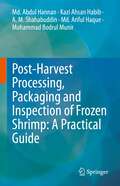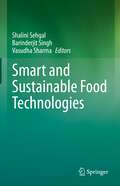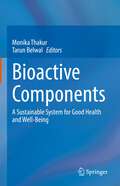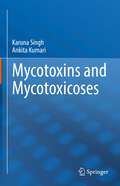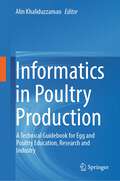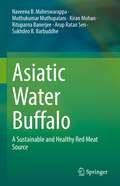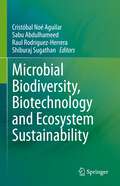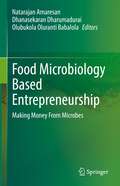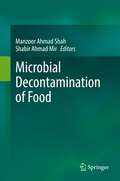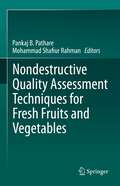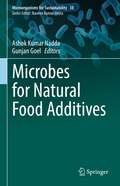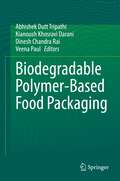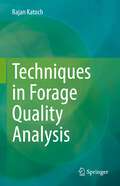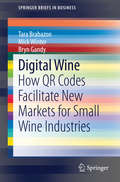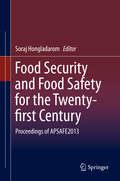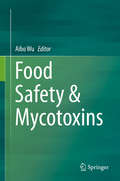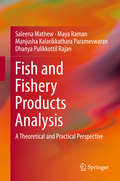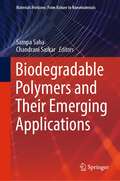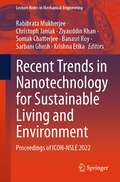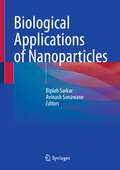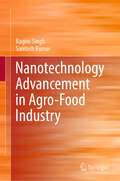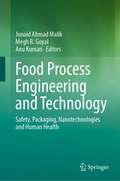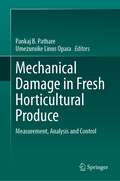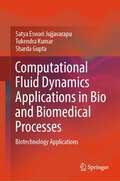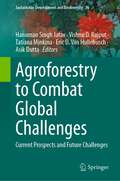- Table View
- List View
Post-Harvest Processing, Packaging and Inspection of Frozen Shrimp: A Practical Guide
by Md. Abdul Hannan Kazi Ahsan Habib A. M. Shahabuddin Md. Ariful Haque Mohammad Bodrul MunirThe book is a practical guide for the various steps in the post-harvest technology of frozen shrimps. Shrimps are one of the most common and popular types of seafood consumed globally. The book discusses some of the most sought-after shrimps such as Penaeus monodon, P. vannamei, and Macrobrachium rosenbergii. Good-quality shrimp is a prerequisite for the seafood business as it is used for human consumption. Lack of proper knowledge in raw materials handling and post-harvest processing is the main obstacle in quality shrimp production. Complex business policy, commitment break in both parties (buyers and sellers), competition with other seafood-producing countries, and fluctuation of currency in international seafood market are the factors affecting international seafood business. This book closes this gap in literature and facilitates the production of excellent-quality exportable frozen shrimp through informed practices from experts. The book includes information about packaging of frozen shrimp, inspection, and shipment. It also compiles different mathematical calculations which are in practiced in the processing industries. The book is essential reading for professionals in the shrimp producing and processing industries. It is also useful for researchers in fisheries science, aquaculture, food technology, and food microbiology.
Smart and Sustainable Food Technologies
by Shalini Sehgal Barinderjit Singh Vasudha SharmaThis book presents a comprehensive view of emerging smart technologies in various food processing sectors. Specifically, it covers smart technologies applied in food production, food manufacturing, food packaging, storage, distribution, and food supply chain. Contributing authors are the key scientists with diverse backgrounds in either industry or academia.The book contains four parts with four chapters each, presenting recent smart technologies developed in their respective areas. Part I primarily focuses on the recent smart food production innovations such as precision agriculture, vertical farming, automation, robotics , livestock technology, modern greenhouse practices, artificial intelligence, and block chain that dramatically increase the quality of raw materials for the food industry. Part II provides the current knowledge and developments related to the recent smart technologies in manufacturing pertaining to various food sectors, non-thermal food preservation technologies, and 3D printing, developed for the food manufacturing industries that improve the organoleptic and nutritional quality, enhance chemical and microbial safety, as well as cost-effectiveness and convenience of processed foods. Part III covers smart technologies to ensure food safety in the supply chain, with monitoring and surveillance of food contamination, use of IoT and blockchain for food traceability and neural network approach for risk assessment. Part IV provides expert opinions on using smart technologies for minimizing waste and maximizing co-product recovery in food processing; upcycling technologies in food and sustainable value stream mapping in the food industry.This book will be a useful resource to graduate/undergraduate students and researchers in advanced food technology, practicing technologists/engineers in the food and related industries, food packaging industry, entrepreneurs and other scientists and technologists in smart and sustainable processes who seek information on design and development of these processes.
Bioactive Components: A Sustainable System for Good Health and Well-Being
by Monika Thakur Tarun BelwalThis book compiles updated information about the role and health benefits of various bioactives in food. Different chapters are contributed by academicians, food scientists, technologists, and medical practitioners. The book addresses both theoretical and applied aspects of bioactive components and provides exhaustive knowledge about bioactive components. It comprises 27 chapters organized into 4 major sections covering topics in food science and technology, functional foods, and nutraceuticals. It provides perspectives for innovation, sources, applications, and sustainability in bioactive component research. The first section starts with introduction of bioactive components consisting of seven different chapters primarily focusing on the bioactive components and their sources with respective health benefits. The second section, comprising five different chapters, deals with different technological trends, regulations, and safety aspects of bioactive components. With eight chapters, the third section covers the role of bioactive components in human health and the role of functional foods in combating various health-related issues. The fourth section reviews functional foods through six chapters that cover the use of bioactive components in various food products. The book will prove useful to advanced food technology graduate and undergraduate students and research scholars, practicing food technologists in food and related industries, entrepreneurs, food-pharma researchers, and other scientists seeking information about smart and sustainable processes as well as information needed to design and develop these processes.
Mycotoxins and Mycotoxicoses
by Karuna Singh Ankita KumariThis book presents a comprehensive view on mycotoxins of agricultural as well as non-agricultural environments and their health effects in humans and animals. Mycotoxins have immunosuppressive effects; but some of them can cause cancers, mutagenicity, neurotoxicity, liver and kidney damage, birth defects, DNA damage and respiratory disorders. The problem of mycotoxins is long-lasting and their direct or indirect exposures to humans and animals must be further discussed. The first chapter will cover the historical perspective of mycotoxins along with timeline while the second one will provide overview including classification of mycotoxins and mycotoxicoses. The comprehensive information/ literature on traditional, emerging and mushroom mycotoxins will be given in chapters 3, 4 and 5 respectively. Chapter 6 will deal with mycotoxins co-occurrence poisoning whereas new and masked mycotoxins will be described in chapter 7. The important aspects of mycotoxin studies like extraction, characterization and analysis and management strategies will be summarized in 8 and 9 chapters. The last chapter of the book will cover the recent developments in toxicokinetic studies of mycotoxins. The book will have the most up-to-date information and recent discoveries to deliver accurate data and to illustrate essential points to a wide range of readers including mycologists, clinicians, agricultural scientists, chemists, veterinarians, environmentalists and food scientists.
Informatics in Poultry Production: A Technical Guidebook for Egg and Poultry Education, Research and Industry
by Alin KhaliduzzamanThis book discusses table and hatching eggs, quality-based grading of eggs, pre-incubation, incubation, hatching and post-hatch monitoring period, and how the next-generation management of these process can be enriched by informatics through non-destructive technologies, signal processing, machine learning, AI, IoT applications, etc. This book will be a beneficial resource for egg and poultry science researchers, avian biologists and ecologists, developmental biologists, agricultural engineers, advanced graduate and postgraduate students, and poultry production industry stakeholders.
Asiatic Water Buffalo: A Sustainable and Healthy Red Meat Source
by Naveena B. Maheswarappa Muthukumar Muthupalani Kiran Mohan Rituparna Banerjee Arup Ratan Sen Sukhdeo B. BarbuddheThis need-based unique book deals exclusively with water buffalo (Bubalus bubalis) meat to provide much needed information to thousands of buffalo meat processors across the world. The information provided in this first-of-its-kind book on buffalo meat quality, nutritional characteristics, safety, and processing can be utilized by buffalo meat producers and meat processors for the advancement of the buffalo meat sector. It also provides valuable information to faculty members, students, researchers, and all other readers interested in this new source of meat. Owing to the limited research and scientific literature available on buffalo meat, the authors’ own research findings and our experiences were included wherever required to give crisp, practical, and complete information. The information proposed in this book should be beneficial to the entire buffalo industry, from the farming and processing of buffaloes to the marketing of products. This serve as a handy guide to meat scientists, faculty members, and students willing to learn more about buffalo meat processing. Up-to-date relevant references were also included for the benefit of researchers and students to enable them to easily access further information. Above all, it provides valuable information to consumers who are interested to know this new and potential source of meat.
Microbial Biodiversity, Biotechnology and Ecosystem Sustainability
by Cristóbal Noé Aguilar Sabu Abdulhameed Raul Rodriguez-Herrera Shiburaj SugathanThis book gives insight into several aspects of the microbiology, biotechnology, and ecosystem sustainability of special and under-explored regions, that captivate human beings by their natural richness, their extensive biodiversity, the extraordinary forms of adaptation of the living beings that they inhabit, and even that keep living secrets as is the very origin of life. The chapters emphasize all aspects of biological diversity-its description, analysis, and conservation, and its controlled rational use by humankind. Also, the book is elaborated from a wide and multidisciplinary point of view. It presents reviews, research papers, comments, and research notes on biodiversity, ethnobiology, geoscience, chemistry, biological conservation, biotechnology, and ecosystem sustainability Two hotspots are the reference for this enriching book that describes details of extraordinary areas of the planet, from Cuatrociénegas, Coahuila (Mexico) to the Southern Western Ghats (India). The book will contribute to dealing with the practicalities of conservation management, economic, social, and political issues. It provides a forum for examining conflicts between sustainable development and human dependence on biodiversity in agriculture, environmental management, and biotechnology, and encourages contributions from developing countries to promote broad global perspectives on matters of biodiversity and conservation.
Food Microbiology Based Entrepreneurship: Making Money From Microbes
by Natarajan Amaresan Dhanasekaran Dharumadurai Olubukola Oluranti BabalolaThis book is first part of the 3 volume set focusing on basic and advanced methods for using microbiology as an entrepreneurial venture. This book deals with the concept of entrepreneurship skills for production, cost-benefit analysis and marketing of button, oyster, milky mushroom, Ganoderma sp, Single cell protein, Breads, Cheese, Yoghurt, Wine, Beer, Probiotics, Prebiotics fermented vegetables, and Fermented Fish etc. Chapters cover the applications of microorganisms in small and large scale production to achieve a sustainable output. This book provides essential knowledge and working business protocols from all related disciplines of food and dairy industry, probiotics industry, mushroom industry, beverage and baking industry, poultry industry, and aquaculture industry etc. This book is useful to graduate students, research scholars and postdoctoral fellows, and teachers who belong to different disciplines via botany, food microbiology, biotechnology, aquaculture microbiology and poultry microbiology. The other two volumes are focused on agriculture and industrial microbiology.
Microbial Decontamination of Food
by Manzoor Ahmad Shah Shabir Ahmad MirFood is contaminated in the production chain and is the point of concern among the consumers and industries. There is also a considerable increase in foodborne outbreaks, which possess the challenge to industry associated with the production of processed food. Various strategies are used to prevent the contamination during postharvest stage, storage and distribution. Different methods are exploited for degrading or eliminating the microbial contamination from food commodities. The conventional techniques used for decontamination demanded a considerable requirement for novel technologies, which are efficient, environmental friendly, and cost-effective. Novel technologies efficiently remove the contamination without adversely affecting the nutritional properties and sensory characteristics of food material. There is a lack of scientific information on the microbial decontamination of different food commodities such as fruits, vegetables, cereals, sprouts, microgreens, meat, poultry, milk, nut, spices etc. under one umbrella. The application of conventional and novel technologies for improving the food safety of individual food commodities will be addresses in this book. Written by several experts in the field, this book is a valuable source for students, scientists, and professionals in food science, food microbiology, food technology, food processing, and other allied sciences.
Nondestructive Quality Assessment Techniques for Fresh Fruits and Vegetables
by Pankaj B. Pathare Mohammad Shafiur RahmanThis book describes the various techniques for nondestructive quality assessment of fruits and vegetables. It covers the methods, measurements, operation principles, procedures, data analysis, and applications for implementing these techniques.The book presents the details of nondestructive approaches focusing on the present-day trends and existing future opportunities in the fresh food supply chain. First, it overviews different nondestructive techniques in food quality detection. Then it presents nondestructive methods: monochrome computer vision, imaging techniques, biospeckle laser technique, Fourier Transform Infrared (FTIR) Spectroscopy, hyperspectral imaging, Raman spectroscopy, near infrared (NIR) spectroscopy, X-ray computed tomography, ultrasound, acoustic emission, chemometrics, electronic nose and tongue. Selected applications of each method are also introduced. As a result, readers gain a better understanding of how to use nondestructive methods and technologies to detect the quality of fresh fruits and vegetables.With a wide range of interesting topics, the book will benefit readers including postharvest & food scientists/technologists, industry personnel and researchers involved in fresh produce quality detection. The book can also serve as a readily accessible reference material for postgraduate students.
Microbes for Natural Food Additives (Microorganisms for Sustainability #38)
by Ashok Kumar Nadda Gunjan GoelThis book provides all the aspects of microbes for food additives, and a detailed description of their different categories. The chapters provide a step-by-step overview of microbial food additives as enzymes, antioxidants, stabilizers, emulsifiers, organic acids, colorants, sweeteners, flavoring compounds that have been used commercially by industrialists. In addition, an emphasis on the use of microbes as therapeutic agents such as probiotics and enzymes have also been given in the respective chapters. Furthermore, the book also comprises the detailed description of legislation and policies for the use of microbial additives at large scale in different food industries. Therefore, this book provides a comprehensive, state of art updated literature which can be used by the food scientists, nutritionists, microbiologists and a health-conscious layman to check the food additive list on a product for a nutritious and safer food.
Biodegradable Polymer-Based Food Packaging
by Abhishek Dutt Tripathi Kianoush Khosravi Darani Dinesh Chandra Rai Veena PaulThis book covers different aspects of biodegradable packaging, such as their sourcing and application in food industries. The book focuses on the production and characterization of biodegradable food packaging derived from plant, animal and microbial sources. Chapters highlight the nano-technological interventions in biodegradable food packaging and the less studied microbial biopolymer-based biodegradable food packaging makes it distinct from other related books. It includes the latest research and development in the areas of food processing, food packaging, material science and polymeric science. It also discusses the standards and regulatory guidelines about the biodegradability testing of these polymers.This book is meant for researchers in food science, food packaging, bioprocess technology, polymer science and biochemical engineering. It is also beneficial for faculty members and students of food microbiology, food technology, dairy technology. The book is also meant for small entrepreneurs and farmers who are interested in bio-plastic usage for food packaging.
Techniques in Forage Quality Analysis
by Rajan KatochThe book covers different techniques and methodologies involved in the nutritional quality analysis of forages. It also discusses the nutritional quality, anti-nutritional components, factors affecting forage quality, feed processing and conservation. Different techniques and methodologies have been presented in a simplified manner. The book has been divided in separate chapters and each chapter discusses different aspect of forage quality. Further, the book also covers the topics on conservation and processing of forages and management techniques for improving the forage nutritional quality. This book is an essential source of information for research scholars, post-graduate students and scientists working on forage quality estimation and also in livestock and dairy industries.
Digital Wine
by Tara Brabazon Mick Winter Bryn GandyThis book explores the way in which QR codes (Quick Response codes) can help the wine industry facilitate distribution and more effectively market and sell their product. It examines the interventions, invention and opportunities brought about by QR codes for the wine industry. It also investigates how QR codes can help enable regional development as well as information and knowledge about winemakers and regions. The book begins with an introduction to QR codes. It explains how to use them as well as shows how QR codes combine analogue and online promotion and information dissemination. Next, the book explores strategies and examples from the creative industries, small nation theory and emerging wine industries. It then goes on to examine how to integrate QR codes with wine media, including marketing the bottle and using QR codes to build new wine regions. The book concludes with a case study of how Aotearoa/New Zealand wine producers deploy QR codes. QR codes can store and digitally present, a range of helpful data, including URL links, geo-coordinates and text and can be scanned by smart phones, making them a useful marketing and business tool. Presenting detail research on how QR codes can enhance the relationship between producers and consumers as well as aid regional development in the wine industry, this book will be of interest to academics focusing on Wine Studies, small and medium sized enterprises (SMEs) and practitioners and researchers from the creative industries sector. In addition, while this book focuses on the wine industry, the information that it presents about QR codes is relevant and applicable for an array of industries that require a tether between analogue and digital, physical and virtual, especially food and primary production.
Food Security and Food Safety for the Twenty-first Century
by Soraj HongladaromThis book is a collection of selected papers that were presented at the First International Conference of the Asia-Pacific Society for Agricultural and Food Ethics (APSAFE 2013), which was held at Chulalongkorn University from November 28 - 30, 2013. The papers are interdisciplinary, containing insights into food security and food ethics from a variety of perspectives, including, but not limited to, philosophy, sociology, law, sociology, economics, as well as the natural sciences. The theme of the conference was to consider the interplay and balance between food security and food ethics as the world approaches the middle part of the twenty-first century.
Food Safety & Mycotoxins
by Aibo WuMycotoxins are increasingly attracting attention at thegovernmental, public and academic level worldwide, due to more frequent and serious contaminations of food and feedstuffs, which pose a serious threat to human health and animal production. This book reviews the latest research on mycotoxins that directly concern food safety, and especially focuses on detection technologies, risk assessment and control strategiescurrently being used in China. Gathering contributions from over 20 respected researchers, the book will benefit graduatestudents, researchers and management groups from various disciplines, including food science and technology, analytical chemistry, plant pathology, public health, etc.
Fish and Fishery Products Analysis: A Theoretical and Practical Perspective
by Saleena Mathew Maya Raman Manjusha Kalarikkathara Parameswaran Dhanya Pulikkottil RajanThis novel and informative book discusses the various aspects of seafood quality. The book is divided into 7 broad sections, each tackling a different aspect. The first section covers the general aspects relevant to the nutritional quality of the fish and the various extraction protocols for macro-/ micro-nutrients. The second section provides insights into handling and the principles of thermal and non-thermal processing techniques for commercially important fishery products. The quality standards and safety concerns in the seafood industry and consumption are discussed in this section. The freshness indices of the processed products including biochemical, microbiological and toxicological characteristics are also included. The third section discusses the physico-chemical characteristics and quality parameters of potable water/ ice. The fourth section includes the quality assessment of various toxicants related to seafood products. The fifth section deals with the specific aspects such as principle, instrument and procedures of conventional and novel analytical instruments relevant to the seafood industry. The sixth section deals with the seafood waste management including solid and liquid seafood wastes. Presently, there is a great awareness regarding environmental sustainable processing/ preservation techniques. The final chapter discusses the bioactive compounds from under-utilized marine sources showing pharmaceutical/ nutraceutical applications.
Biodegradable Polymers and Their Emerging Applications (Materials Horizons: From Nature to Nanomaterials)
by Sampa Saha Chandrani SarkarBio-degradable polymers are rapidly emerging as a sustainable alternative to traditional petroleum-based plastics and polymers. However, the synthesis and processing of such polymers present unique challenges and opportunities. In this comprehensive volume, Dr. Saha and her team provide an in-depth exploration of the synthesis and processing of bio-degradable polymers and their emerging applications in various sectors from drug delivery to food packaging. Covering a wide range of topics, including synthesis, modification, processing techniques, and few of their advanced applications in emerging areas, this book provides a comprehensive overview of the field. The authors also delve into cutting-edge research on the synthesis, properties and applications of bio-degradable polymers in various fields, such as agricultural, food preservation, biomedical arena, energy storage and other advanced application areas. This volume is an essential resource for scientists, engineers, and policymakers interested in the future of sustainable materials. Whether you are a researcher looking to expand your knowledge of biodegradable polymer synthesis and processing or a policymaker interested in the potential of biodegradable polymers to reduce our reliance on fossil fuels, this book is an invaluable guide to the field.
Recent Trends in Nanotechnology for Sustainable Living and Environment: Proceedings of ICON-NSLE 2022 (Lecture Notes in Mechanical Engineering)
by Rabibrata Mukherjee Christoph Janiak Ziyauddin Khan Somak Chatterjee Banasri Roy Sarbani Ghosh Krishna EtikaThis book presents the select proceedings of International Conference on Nanotechnology for Sustainable Living and Environment (ICON-NSLE 2022). It covers the latest trends in nanotechnology and its applications in various sectors such as energy, environment, food technology, and biomedicine. Various topics covered in this book are nanomaterial preparation and characterization, nanobiotechnology, nanodevices, waste to wealth, pollution abatement, renewable energy, advanced materials, sensors and portable electronics, biomedical applications, food preservation, etc. This book is useful for researchers and professionals working in the area of nanotechnology and environment sustainability.
Biological Applications of Nanoparticles
by Biplab Sarkar Avinash SonawaneThis textbook for graduate and postgraduate students provides comprehensive applications of nanoparticles in medicine, agriculture, and environmental sciences. The initial chapter covers basic topics related to types, synthesis, structure, and properties of various nanoparticles. It further discusses the wide range of applications of nanoparticles in medicine, agriculture, and the environment. The book presents nano-electronic biosensors that are used to diagnose and monitor the progression of human diseases. It summarizes the opportunities and challenges of nanotechnology in the agriculture and food sector highlighting the scientific, technical, regulatory, safety, and societal impacts. Additionally, it illustrates the applications of nanotechnology in the field of aquaculture medicine, bioinformatics and food technology. The textbook examines the development and administration of nano-medicines , their applications, advantages, and limitations for the treatment and prophylaxis of a broad range of diseases. Lastly, the textbook explores the recent advances in the field of nanobusiness and nanotechnology issues in intellectual property management( IPR).
Nanotechnology Advancement in Agro-Food Industry
by Ragini Singh Santosh KumarThis book provides a comprehensive insight into the growth of nanotechnology in the agri-food industry. Currently, nanotechnology serves as the most promising means to resolve the issues encountered in the food sector, as it enables the production of high-quality food with exceptional characteristics such as extended shelf life, flavor, freshness, and high nutritional content. This book focuses on the applications of nanotechnology in various fields such as smart packaging, processing, and preservation of food. It also emphasizes the role of nanomaterials in strategic design of nutraceuticals and functional foods. Along with providing an overview of the innovations and application, this book also describes future perspectives, and offers insights to ensure consumer confidence in terms of safe use. In this context the application of nanomaterials as nanosensors is additional covered. The book provides readers with a deep knowledge regarding nanomaterials-based biosensors (colorimetric, electrochemical, fiber-based) for detection of pathogens in contaminated food. Factors affecting risk assessment regulations and safety concerns regarding the use of nanomaterials in food industry have also been discussed in detail. Given its scope, this book appeals to a wider readership, especially for researchers and students who work in food agronomy and nanomaterials and nanotechnology related fields.
Food Process Engineering and Technology: Safety, Packaging, Nanotechnologies and Human Health
by Junaid Ahmad Malik Megh R. Goyal Anu KumariThis book focuses on novel technologies related to food processing technology and engineering. It also focuses on food safety, quality and management, the scope of the Internet of Things (IoT) in food processing and its management, bioengineering tools for crop improvement in agriculture, recent innovations in food packaging, nanotechnology in food processing, and the nutritional health benefits of food. 3D printed food, an interesting and increasingly popular concept among the public today, is a meal prepared through an automated additive process using 3D food printers. This book is a ready reference for food researchers, students, and industry professionals. The book updates the current scenario of food processing technology and engineering for readers from agriculture and its allied fields including students and researchers of food science and technology, dairy science and technology, packaging industry, people working in food safety organisations, and researchers in the field of nanotechnology.
Mechanical Damage in Fresh Horticultural Produce: Measurement, Analysis and Control
by Pankaj B. Pathare Umezuruike Linus OparaThis book includes the impact, compression, vibration studies, and destructive and nondestructive techniques for bruise measurement. It is essential to detect bruises in the early stages of their formation and conduct a quantitative analysis of the degree of bruising, to ensure the accurate grading of bruised fruits and vegetables and reduce unnecessary economic losses. Bruise damage occurring between the point of harvest and consumption contributes the most to the decrease in fruit quality, reducing the market value and ultimately leading to significant reductions in potential revenue. SDG 12.3 aims to “by 2030, halve per capita global food waste at the retail and consumer levels and reduce food losses along production and supply chains, including post-harvest losses.” This book presents recent technological developments in bruise measurement, detection, and analysis of fresh horticultural produce. Given the rising demand for rapid and accurate methods of quality measurement in the horticultural produce industry, this book covers destructive and nondestructive techniques for bruise measurement. Selected applications of different nondestructive methods for various fresh produce commodities are also included. This book will interest graduate and undergraduate students, researchers, academics and engineers working in different aspects of the mechanical damage affected by postharvest handling practices, professionals working in the governments, and other authorities related to fresh horticultural produce quality, regulations, and safety.
Computational Fluid Dynamics Applications in Bio and Biomedical Processes: Biotechnology Applications
by Satya Eswari Jujjavarapu Tukendra Kumar Sharda GuptaThis book covers emerging areas in novel design and their hydrodynamic properties relevant to bioreactors, environmental system, electrochemical systems, food processing and biomedical engineering. This book uses an interdisciplinary approach to provide a comprehensive prospective simulation modeling and hydrodynamic study in advanced biotechnological process and includes reviews of the most recent state of art in modeling and simulation of flows in biological process, such as CFD. Written by internationally recognized researchers in the field, each chapter provides a strong introductory section that is useful to both readers currently in the field and readers interested in learning more about these areas.
Agroforestry to Combat Global Challenges: Current Prospects and Future Challenges (Sustainable Development and Biodiversity #36)
by Hanuman Singh Jatav Vishnu D. Rajput Tatiana Minkina Eric D. Van Hullebusch Asik DuttaThis edited book brings out comprehensive insights on agro-forestry systems to cope up climate change globally. The main essence of this book is to unfurl the positive sides of agri-silvipastoral system to reduce greenhouse gases (GHGs) and temperature. Agro-forestry can be defined as the farming practice combining field crops, perennial trees and livestock. The impact of agro-forestry on ecology is implacable which is thoroughly discussed under different heads in this book. In addition, the book is bundle of different novel sections including tables, graphical representation, and figures showcasing the bright side of agro-forestry system. Furthermore, trees which are important component of boosting socio-economic conditions, especially for the indigenous populations have also been discussed meticulously. Hence, all together this book deciphers an account of agro-forestry practices in society and environment along with the major pros- and cons- of the system. Undoubtedly, this information could enrich the scholarly knowledge for graduate research fellows, teachers, scientists, researchers, and environmentalists in gaining multifaceted information of agro-forestry system in both ecological and economical aspects. Different research highlights will be helpful for the policy makers to implement this novel practice in intensive production systems and harness the maximum benefits out of this.
